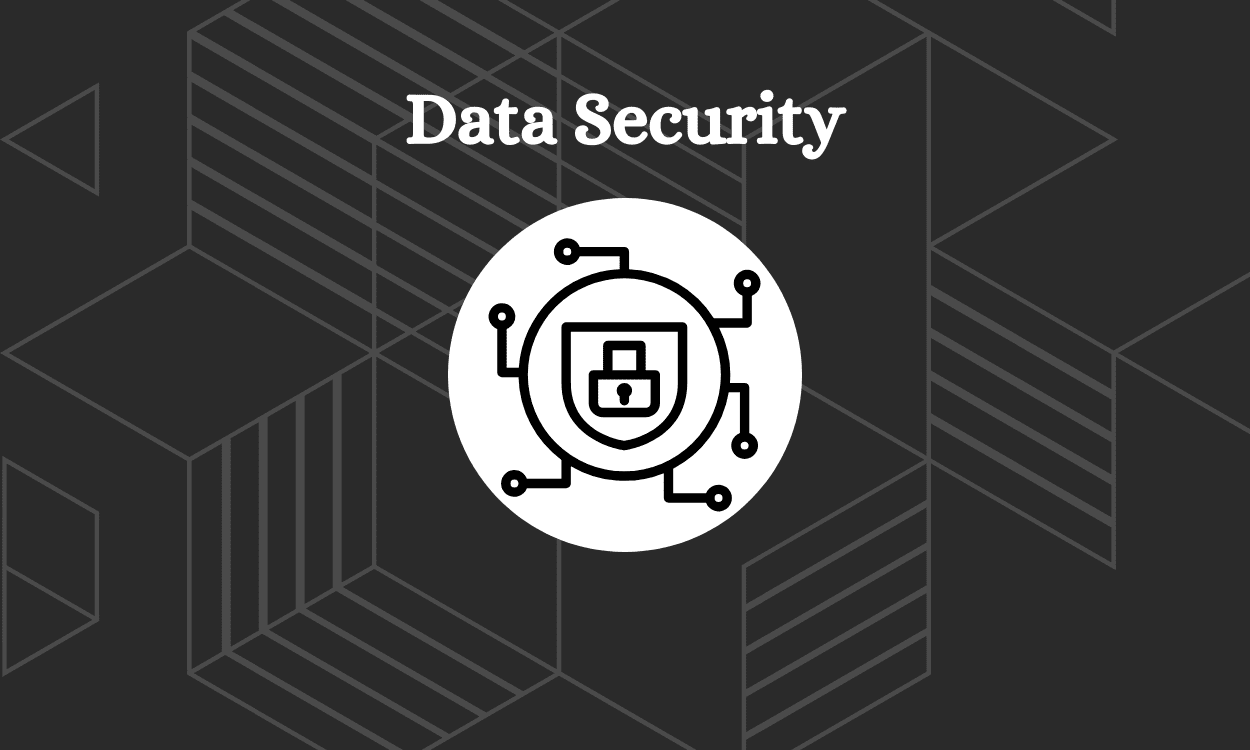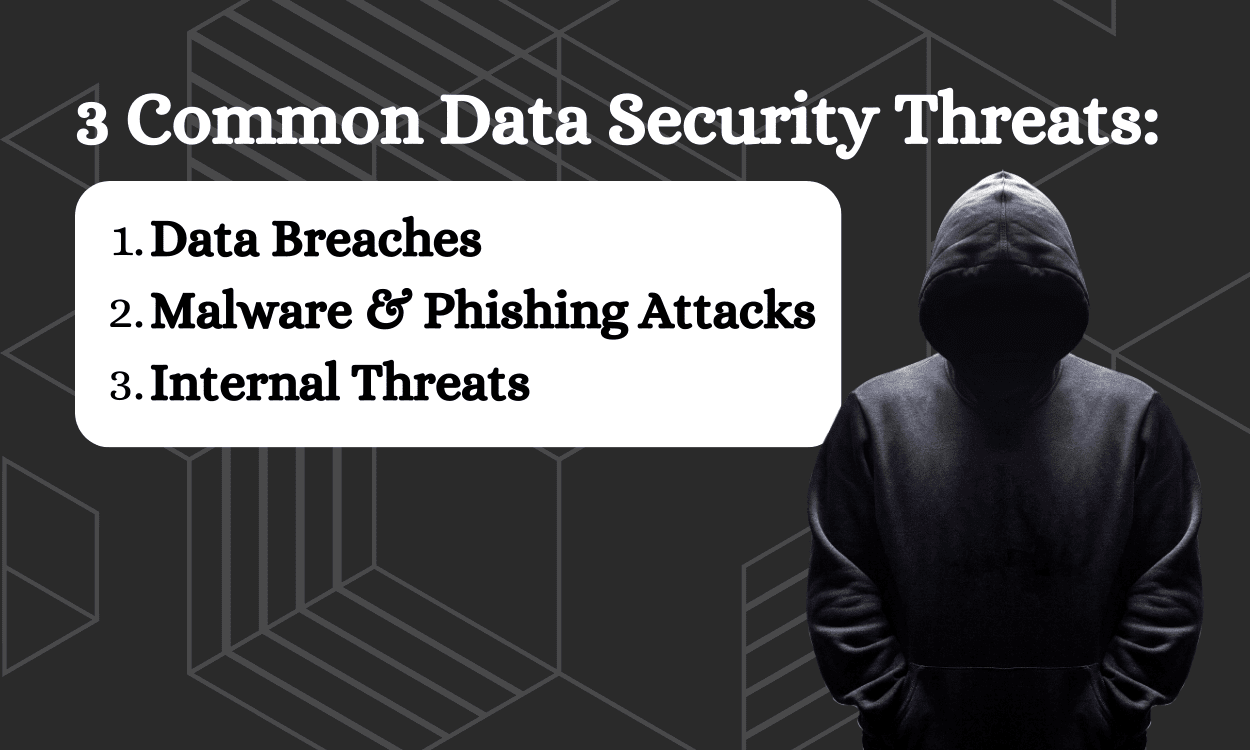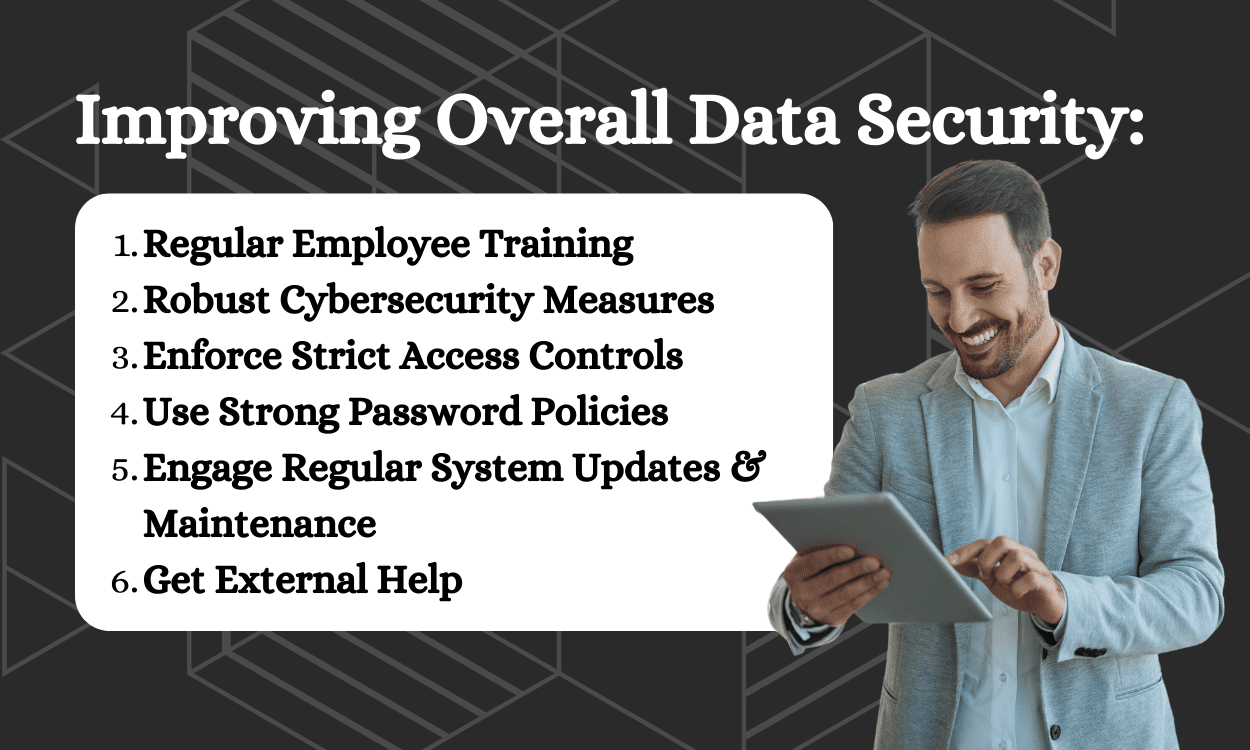
- Home
- Cybersecurity Tips
- Common Types of Data Security Challenges and How to Avoid Them
Common Types of Data Security Challenges and How to Avoid Them
In our digital age, data is gold (or the “New Oil” depending on the industry). With its immense value however comes an inverse proportion of challenges – potential hazards consistently lurking in the shadows, waiting for a lapse in vigilance to strike. Threats from both external malefactors and internal oversights fuel the necessity for stringent measures to safeguard this critical asset. This article tackles common data security issues we encounter today and presents practical steps to prevent their occurrence, arming you with valuable knowledge – your first line of defense.


Data Security Explained: Definition, Risks and Technologies
Data security can be simply defined as the suite of practices and protocols designed to protect digital information from unauthorized access, corruption, or theft during storage or transit. A robust layer of protection enveloping your digitized treasure trove – that’s what good data security boils down to.
You may liken it to a modern-day castle keep; deflecting onslaughts from besieging enemies (malware attacks), guarding against treacherous insiders ‘going rogue’ (internal threats), or shunning crafty disguises worn by deceitful invaders at the drawbridge (phishing).
As clear-cut as its role seems though, complexities arise when diving into the numerous cybercriminal exploits that necessitate highly innovative technology solutions specifically crafted to combat them. These range from firewalls and encryption technologies right up till advanced machine learning algorithms sniffing out abnormal activities.
Additionally, adjusting for continually evolving cyber threats plus mitigating information security risks like inadvertent staff errors or device losses into the equation – all these underline why ensuring data security isn’t merely installing an antivirus software but rather enforcing a well-rounded strategy inclusive of personnel education and policy management as well.
Let’s now delve deeper into a few specific areas where these precautions become necessary – delving into common aspects where data becomes susceptible to unauthorized intrusion and how precisely we can guard against those breaches.

3 Different Types of Data Security Threats:
When discussing data security, three significant threats persistently emerge: Data breaches, malware & phishing attacks, and internal threats. It’s crucial to understand these unique challenges to circumvent cyber security risks efficiently.
1. Data Breaches
A data breach, one of the most common and dangerous data security risks, occurs when unauthorized individuals access information stored in a cognitive database. These cybercriminals exploit vulnerabilities to steal valuable private, corporate, or government data.
What They Are?
Often an external attack, a data breach can expose sensitive customer information or intellectual property. This illegitimate access might aim at gathering personal identifiers – such as name and social security number—financial details like credit card information or bank account numbers, password credentials, health records or trade secrets. The stolen data is then potentially used for fraudulent activities, sold on the black market (commonly known as Dark Web), or sometimes even publicized, thereby impacting the victims’ reputations irreparably.
Common Causes
Data breaches usually happen due to several reasons:
- Cyberattacks: Hackers typically rely on malware attacks, exposed vulnerabilities, or phishing schemes to compromise your computer’s defenses and gain unauthorized access.
- Insider threats: Disgruntled employees may share sensitive company information deliberately.
- Poor security protocols: Weak passwords are often cracked through brute force attacks; outdated software provides loopholes for exploitation.
- Physical thefts: Stolen devices like laptops may contain confidential information that isn’t encrypted or protected properly.
How to Avoid Them
Preventing catastrophic consequences from a data breach requires meticulous planning:
- Audits and Assessments: Penetration tests, vulnerability scans, and security assessments and reviews by a qualified third party (Like Class IV).
- Encryption: Implement strong encryption methods for all sensitive data and maintain a secure backup.
- Updates: Regular software updates should be mandatory to patch potential vulnerabilities.
- Training: Train employees frequently on cybersecurity best practices – this includes using strong passwords and recognizing potential phishing attempts.
- Governance: Risk appropriate physical security controls should be enforced around servers and services storing and processing sensitive data.
Lastly, instituting 24/7 monitoring systems can help defect any anomalies before they manifest into full-blown catastrophes.
Undoubtedly then proactive strategies geared towards comprehensive defense mechanisms can significantly mitigate these data security risks. It’s far more efficient to prevent a data breach than to manage the aftermath of one!
2. Malware & Phishing Attacks
What They Are
Malware, a condensed term for malicious software, encompasses a broad range of harmful programs designed to infiltrate and damage or gain unauthorized access to your systems. These include viruses, worms, Trojans, ransomware, and spyware.
On the other hand, phishing attacks represent cleverly designed deceptive strategies deployed by cybercriminals. The primary goal is to manipulate you into revealing sensitive data such as login credentials or credit card numbers. Often, these attacks are executed through seemingly legitimate emails or websites that prompt the user to provide personal information.
Common Causes
The most common cause of malware infections remains ill-advised clicking on unverified links or downloading suspicious attachments – typically distributed via email or social media. Moreover, it’s not uncommon for such malware to come disguised as software updates, text messages, or downloads from dubious sources free of protective measures.
Phishing attacks mainly derive their success from social engineering exploits: tactics that tap into human psychology. Typically exploiting emotions like fear and urgency, attackers convince potential victims to reveal sensitive data hastily without realizing the hidden trap within enticing promotional offers or alarming security alerts.
How to Avoid Them
Fortifying your defense against both malware and phishing attacks requires continuous commitment coupled with strategic approaches:
- Maintain Updated Software: Regularly update all applications including antivirus software to ensure an optimal defense against evolving threats.
- Be Skeptical: Always double-check emails especially those prompting action related to financial transactions or sensitive data disclosures.
- Secure Networks: Utilize secure network connections (VPNs), particularly when accessing public Wifi networks which tend to be more vulnerable.
- Staff Training: Employees should regularly undergo training sessions on recognizing phishing attempts and unsafe online behavior.
- Backup Data: Regularly backup important data offsite or in cloud storage solutions providing comprehensive disaster recovery capabilities.
By understanding how malware and phishing operations function and implementing robust preventative measures, you can significantly decrease the likelihood of a devastating breach. Always remember that in cybersecurity, an ounce of prevention is worth a pound of cure.
Therefore, enhance your vigilance and fine-tune your security practices regularly to stay ahead of evolving threats.
3. Internal Threats
What They Are
Often when we think of data security threats, our mind jumps directly to external hackers and viruses. However, the reality is that internal threats pose a significantly grave challenge in securing our valuable digital assets. In essence, internal threats are potential risks that originate from within the organization itself.
They encompass every possible harm that can come from inside: it could be an employee who unwittingly clicks a malicious phishing link or a disgruntled worker intentionally releasing sensitive information. Even third-parties with access to the company’s resources like vendors, contractors, or partners could inadvertently become sources of internal threats.
Common Causes
The causes behind internal data security threats may vary greatly but can usually be classified into three main categories:
- Negligent Employees: This category involves individuals who unintentionally cause security incidents due to their carelessness or lack of knowledge about proper protocols. For instance, this might include someone creating easy-to-guess passwords, leaving devices unattended in public places or failing to update software regularly.
- Malicious Insiders: Unlike negligent employees, these actors purposefully seek to damage the organization for reasons ranging from personal gain, revenge against perceived wrongs or simply discontentment within their role.
- Cybersecurity Policy Gaps: It’s critical not to overlook system administration errors and inadequate cybersecurity policies as potential risk factors that lead to internal breaches. If regular audits aren’t conducted and employees aren’t trained on the latest best practices then this can create exploitable gaps in your digital armor.
How to Avoid Them
So how does one protect their enterprise from these formidable yet often invisible adversaries? Here are some measures you can implement:
- Regular Employee Education and Training: Keep your workforce enlightened about existing security policies and emerging cyberthreat trends through frequent training sessions.
- Strong Access Controls and User Management Policies: Implement stringent controls over access rights limiting permissions strictly based on need-to-do basis. A robust user management approach ensures lesser access to sensitive information, thus reducing potential internal threats.
- Employee Monitoring and Network Analytics Tools: These technologies can help detect any unusual activity or behavior within the company network and permit immediate action against it.
As we step further into an era where data is the new gold, securing it from possible breaches becomes imperative. Do remember that security doesn’t solely mean guarding from external invaders but also from potential dangers lurking within our own walls.

How a Business Can Improve Overall Data Security
Achieving data security in the business environment is not an overnight task; it demands consistent effort, informed strategies, and the right mindset. Here are a few effective ways you can enhance your company’s data security:
- Regular Employee Training: It might appear simple on the surface, but many breaches stem from simple errors made by uninformed or complacent employees. That’s why regular training sessions aimed at familiarizing all levels of staff with essential data security practices are important.
- Implement Robust Cybersecurity Measures: This encompasses up-to-date antivirus software, firewalls, malware protection, and intrusion detection systems. By putting these key cybersecurity measures into place, potential threats can be quickly noticed and addressed before they escalate.
- Enforce Strict Access Controls: Not everyone in a company should have access to all forms of data. Determining who needs access to what information and limiting it accordingly reduces potential internal threats.
- Use Strong Password Policies: One of the simplest yet crucial steps for enhancing data security is implementing strong password policies – passwords should be robust (complicated enough not to be easily hacked) and frequently updated.
- Engage Regular System Updates & Maintenance: Consistently maintaining and updating your system helps patch any security vulnerabilities that could potentially serve as entry points for cybercriminals.
- Get External Help: Engaging a specialized data consulting service such as Class IV CIO services ensures the safety and integrity of your data. Their expertise in data protection provides a robust shield against potential breaches and threats.
Remember that this isn’t an exhaustive list; businesses must consistently evaluate their unique requirements against evolving technological contexts to create dynamic data security procedures. Business resilience requires proactivity in addressing potential risks sooner rather than later, anchoring a culture that respects both technology use and its prudent management within every enterprise level.
Embrace Cyber Hygiene
In essence, improving overall corporate data security boils down to practicing good cyber hygiene: the steps taken regularly (not merely when trouble arises) to ensure minimal exposure to common threats while keeping software healthy—much like brushing teeth ensures dental health. Recognizing the importance of data security and cyber hygiene, integrating them in everyday business practices, and maintaining an informed workforce are central steps in fostering a cyber-secure environment within any company.
It’s indeed easier said than done but not impossible to implement. Together with your team, you can create a more secure digital habitat where everyone understands their roles in keeping organizational data safe. After all, data security isn’t just IT’s job—it’s everyone’s responsibility.
Need Some Cyber Support?
Conclusion
As we’ve journeyed through this complex terrain of data security threats, understanding their intricacies and learning about prevention strategies is crucial. Let’s take a moment to muse on the critical points we’ve covered.
Firstly, remember that no business or individual in our digital age is immune to data security challenges. From high-profile data breaches down to crafty phishing schemes and elusive internal threats, these issues are commonplace across industries.
Next, adopting a robust cybersecurity stance isn’t only smart but essential in the current era. That means implementing necessary safeguards such as firewalls and antivirus software, educating employees about possible threats, using encryption measures for sensitive information, and practicing secure password protocols.
Finally yet importantly, tackling data security challenges involves maintaining an alert mindset – staying updated with evolving threat scenarios and adjusting your measures accordingly. After all, your response strategy continually needs recalibration because cyber attackers seldom repeat the same tactics over time.
On reflection then, it’s clear that awareness is the keystone of averting data security crises – being fully apprised of potential hurdles allows us to develop flexible solutions catering not just for today’s challenges but also future ones. In doing so, we display resilience in the face of uncertainty and ensure our greatest asset–our data–remains uncompromised.
No doubt the path forward can appear daunting at times; nevertheless approaching it actively rather than reactively will render you better prepared to navigate whatever comes next confidently. Thankfully though you needn’t walk this road alone – there exists an abundance of resources online (and possibly within your organization) that can assist you during each stage of this ongoing journey towards improved cybersecurity!

